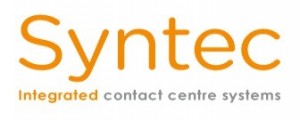Syntec reveal ten tips for offering callers a positive IVR experience
 IVR (interactive voice response) is a powerful tool and, when used well, can help you significantly improve the service that you offer callers to your contact centre as well as offer you greater operational efficiency. However when it’s badly used, IVR can be a huge source of frustration for callers and ultimately results in lost business. In this article I suggest ten best practice guidelines to make sure that your IVR system reflects positively on your brand and helps callers get what they need rather than hindering them.
IVR (interactive voice response) is a powerful tool and, when used well, can help you significantly improve the service that you offer callers to your contact centre as well as offer you greater operational efficiency. However when it’s badly used, IVR can be a huge source of frustration for callers and ultimately results in lost business. In this article I suggest ten best practice guidelines to make sure that your IVR system reflects positively on your brand and helps callers get what they need rather than hindering them.
1. Have a variety of hold messages – sometimes placing callers on hold for a period of time is unavoidable but there are things you can do to make the wait more bearable and reduce the chances of lost calls at this stage. One of these is to have a variety of hold messages so callers aren’t constantly being presented with the same message repeated multiple times. Two or three different messages in rotation is much less annoying, whilst having dozens of messages also suggests you’re expecting them to wait a long time, so can be counterproductive.
2. Limit the number of options with which callers are presented – human memory is limited so don’t offer people more than 4 or 5 options in any one menu. Less is more here. Faced with a long list of options, callers will become confused or forget which option they need by the time the end of the list is reached. Similarly, try and avoid having too many menu levels. It’s annoying to keep selecting options only to be presented with further submenus of options. Look at all your menus and menu options. Are they all necessary? I’ve seen examples of hugely complex IVR systems containing numerous menus and menu options, most of which ultimately point to the same place. There’s just no sense in annoying people for no reason.
3. Don’t overload callers with long introductory messages – it can be tempting to present callers with long recorded introductions giving them information about special offers or telling them about all the things they should have to hand during the call. Such messages often end up telling callers things they already know, or mean that it takes much longer for them to get to the service they require. If your contact centre is reasonably well-staffed then the chances are that you’ll be answering the call before the message has fully played anyway, which is also annoying.
4. Always offer the option of talking to someone – it’s not going to be possible to automate every single aspect of your customer transactions. There will always be someone who has a question or need that you hadn’t thought of when you were designing your IVR system. Everyone knows how frustrating it is to be presented with endless menus and options, none of which answer your specific question. Always have a ‘press X to speak to an operator’ option somewhere in your system.
5. Think carefully about your choice of hold music – well-chosen hold music can distract callers from the boredom of being put on hold and reduce the number of complains you get about waiting times. Your choice of hold music also says something about your brand – often your hold music will be one of the first things that a potential customer hears from you. Think also about the nature of the calls coming in. It may not be appropriate to play upbeat poppy music if people are typically annoyed or calling to complain, or if that type of music doesn’t fit with the nature of your brand. Given our large travel industry customer base we created a genre of hold music intended to get people excited about going on holiday, which feedback suggests makes it easier to up-sell holidays.
6. Use a combination of hold music and recorded messages – a long, uninterrupted period of hold music (or, even worse, silence) can lead callers to worry that they’ve become somehow lost in your system and increases the chances of abandoned calls. Breaking up the hold music from time to time with courtesy messages can reassure callers that you know they’re there and they haven’t been forgotten about.
7. Use your IVR system to direct callers based on what you already know about them – a good IVR system will enable you to direct callers to the right agent automatically based on their previous interactions with you (or even what they’ve been looking at on your website, using Syntec’s ResponseTrack system). Similarly you can offer a personalised set of menu options based on what you already know about a customer, rather than presenting everyone with exactly the same options whether the caller is one of your best customers calling to check an order or an unhappy customer with an outstanding complaint. Presenting callers with personal messages and menu options shows that you’re thinking about who they are and what they need.
8. Choose the IVR voice carefully and ensure all the messages sound professional – this is about both making the system easier for callers to navigate and presenting your brand in a professional manner. Get your IVR messages properly recorded in a clear and professional-sounding voice. Think about things like the speed of the message. Too slow can sound patronising and dull. Too quick can mean that callers miss crucial information. This is particularly important if you’re giving out phone numbers or web addresses that callers need to be able to note down.
9. Don’t force callers through your menu options only to discover that your call centre is closed – there’s no excuse for forcing callers through a labyrinthine set of menu options only to present them with a message saying that the contact centre is closed and they should call back later at the end of it all. However if you do have different departments closing at different times, a time switch at the top with the greatest available opening times can be supported by time switches specific to different departments.
10. Let the caller know about the benefits of IVR – too often IVR is presented as something that the caller has to spend important time navigating through in order to be able to get at what they really want. But there are benefits for IVR for callers as well as for your company. Many transactions can be done automatically and quickly through IVR and it isn’t always necessary to speak to someone (for instance our CardEasy keypad payment by phone system has a customer self-service option using IVR). This saves your callers’ time as well as your own and well-chosen IVR messages can make this much clearer to people. Consider the difference between “Press one for the quickest and easiest way to pay your bill” compared with “Press one to access our automated payment lines”.
What most of this advice really boils down to is putting yourself in the caller’s shoes. IVR is a hugely powerful technology and it’s easy to get caught up in the endless possibilities and options and forget what the experience is like from the caller’s point of view. But we’re all consumers ourselves and we all know what’s annoying and what isn’t when we’re navigating our way through other people’s IVR systems. Too often, however, this experience gets forgotten when it comes to building our own. Hopefully these ten tips provide some pointers to help develop more effective IVR systems that go beyond simply not annoying people and towards making the caller’s IVR experience an actively positive one.
 Additional Information
Additional Information
Alex Cooksey – Syntec
Alex studied computer science at Southampton University before joining EccoWare. There he looked after quality assurance and customer services, working directly with proprietary derivatives traders (those who trade their own money) and learning first-hand how to deal with customers whose entire fortunes rest on whether your software works as promised.

For additional information on Syntec view their Website or Company Profile
 Additional Information
Additional Information



